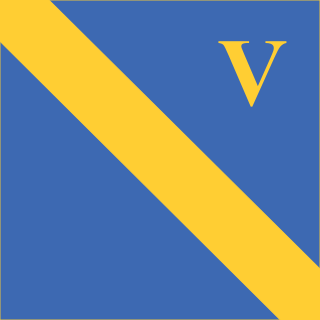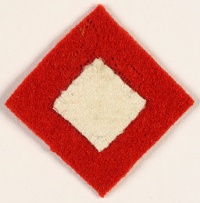The 1st Army Tank Brigade was a formation of the British Army during the Second World War. A Tank Brigade was intended to support the Infantry and was mostly equipped with slow moving Infantry tanks, unlike an Armoured Brigade, which was equipped with faster cruiser tanks and later its own motorised infantry. Initially using infantry nomenclature for its smaller units, company and section and having 175 light and infantry tanks, it later adopted cavalry nomenclature of squadron and troop and later in the War grew to 240 tanks.

The 4th Infantry Division was a regular infantry division of the British Army with a very long history, seeing active service in the Peninsular War, the Crimean War, the First World War, and during the Second World War. It was disbanded after the war and reformed in the 1950s as an armoured formation before being disbanded and reformed again and finally disbanded on 1 January 2012.

The 5th Infantry Division was a regular army infantry division of the British Army. It was established by Arthur Wellesley, 1st Duke of Wellington for service in the Peninsular War, as part of the Anglo-Portuguese Army, and was active for most of the period since, including the First World War and the Second World War and was disbanded soon after. The division was reformed in 1995 as an administrative division covering Wales and the English regions of West Midlands, East Midlands and East. Its headquarters were in Shrewsbury. It was disbanded on 1 April 2012.

The 1st Division, formerly known as the 1st Armoured Division, is a division of the British Army. It has recently returned home from being stationed in Germany. Originally formed in November 1937 as the Mobile Division, it saw extensive service during the Second World War and was disbanded afterwards; reconstituted in 1976, it remains in service. It should not be confused with the 1st Infantry Division.

The 11th Armoured Division was an armoured division of the British Army which was created in March 1941 during the Second World War. The division was formed in response to the unanticipated success of the German panzer divisions. The 11th Armoured was responsible for several major victories in the Battle of Normandy from in the summer of 1944, shortly after the D-Day landings of 6 June 1944, and it participated in the rapid advance across France, Belgium, and the Netherlands and, later, the Rhine crossing in March 1945, and later invaded Germany. It was disbanded in January 1946 and reformed towards the end of 1950. In 1956, it was converted into the 4th Infantry Division.
The 43rd Royal Tank Regiment was an armoured regiment of the British Army's Royal Armoured Corps that tested and demonstrated specialised Armoured Fighting Vehicles during World War II.

The 21st Army Tank Brigade was an armoured brigade formation of the British Army active during World War II. The brigade served with the British First Army and the British Eighth Army during the fighting in Tunisia and Italy.
The 20th Independent Infantry Brigade was an infantry brigade of the British Army, raised during the Second World War.

The 6th Armoured Division was an armoured division of the British Army, created in September 1940 during the Second World War. In October 1940, armoured regiments within the Division, such as the 2nd Lothian and Border Horse, were supplied with Matilda MkI.I tanks, then in May 1942 Crusader MkII tanks, in August 1942 Valentine Mk.V tanks and finally in October Crusader MKIIIs. In North Africa tankers were finally put on an almost equal footing to their Panzer counterparts when the M4A2 Sherman medium tank was added to their inventory by March 1943. In November/December 1942 The division participated in the Operation Torch assault landings in Bone, closest to the Axis Forces in all the Torch landings that stretched from Morocco to the Tunisian border. In November 1942 they saw their first action as part of V Corps of the British First Army, First Allied Army in the Tunisia Campaign. In March 1943, around the same time when most of the units had been supplied with American M4A2 Shermans, the Sixth Division came under IX Corp. After Tunisia, the Division participated in the Italian Campaign as part of the British Eighth Army and ended the war in Austria, again under the command of V Corps.

The 23rd Armoured Brigade, originally formed as the 23rd Army Tank Brigade, was an armoured brigade of the British Army that saw service during the Second World War. The brigade was a 2nd Line Territorial Army (TA) formation. It was reorganised and renamed the 23rd Armoured Brigade, when it was assigned to the 8th Armoured Division, although it never operated under command of the division.
The 10th Armoured Brigade was a short-lived armoured brigade of the British Army in World War II. It had been converted in November 1941 from infantry battalions, but had never seen action and was disbanded in late 1943.

The 9th Armoured Division was an armoured division of the British Army, raised during the Second World War. It never saw active service during the war as a complete division.

The 29th Armoured Brigade was a Second World War British Army brigade equipped with tanks that formed the armoured component of the 11th Armoured Division.
The 24th Army Tank Brigade was an armoured brigade of the British Army. It was embodied in the United Kingdom at the outbreak of World War II. On 1 November 1940 it was redesignated as the 24th Armoured Brigade and reorganized. In July 1942 it transferred to Egypt and took part in the Western Desert Campaign, notably the Second Battle of El Alamein. The Headquarters was disbanded in the Middle East on 1 March 1943.

The 10th Armoured Division was an armoured formation of division-size of the British Army, raised during World War II and was active from 1941–1944 and after the war from 1956–1957. It was formed from the 1st Cavalry Division, a 1st Line Yeomanry unit of the Territorial Army (TA) which had previously been serving in Palestine. The division was converted from cavalry to armour and redesignated from 1 August 1941.

The 42nd Armoured Division was an armoured division of the British Army raised during the Second World War.

The 29th Infantry Brigade was an infantry brigade unit of the British Army. It was originally raised in 1914 and saw service during the First and Second World Wars and the Korean War.
Brigadier Philip Ernest Bowden-Smith CBE, was a cavalry officer and later armoured commander of the British Army who served in the First World War and the Second World War. Described as 'one of the finest horsemen of his generation' he also represented Great Britain at the 1924 Olympic Games.
The 3rd Armoured Brigade, previously the 1st Heavy Armoured Brigade, was an armoured brigade of the British Army that saw service in the Second World War with the 1st Armoured Division and the 2nd Armoured Division in the North African Campaign. The brigade headquarters was disbanded on 11 January 1943.












